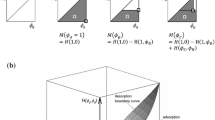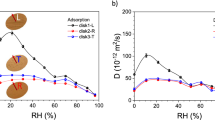Summary
A mechanistic description and quantitative mathematical expressions are developed for the net migration rate through wood of water in the bound and vapor phases. Diffusion of bound water is driven by the gradient in the chemical potential of the bound water molecules while water vapor diffusion is driven, by the gradient in the mole fraction of water in the gas phase. Vapor and bound water are assumed always to be in local thermodynamic equilibrium. An original mathematical derivation grounded on fundamental thermodynamic relationships is applied to the bound water chemical potential in order to express the rate of bound water diffusion in terms of only the local temperature and water vapor pressure. Published experiments on nonisothermal moisture migration rates in wood are compared to the solutions of this equation and also others which have been recently proposed in the literature. Results from the equation developed in this paper are in closest agreement with the reported experimental data. This success may be attributed both to the thermodynamically correct expression derived for bound water chemical potential and to recognition of the important contribution of gas phase diffusion to total moisture migration rates.
Similar content being viewed by others
Abbreviations
- CP :
-
heat capacity, J/mole-K
- c:
-
molar density, moles/m3
- Db :
-
thermal diffusion coefficient, %db/K
- Dv :
-
vapor diffusion coefficient, kg/m-s-Pa
- D eff :
-
effective gas diffusivity, m2/s
- D b (1) :
-
bound water diffusion coefficient, kg/s-m3
- D b (2) :
-
bound water diffusion coefficient, kg/s-%db
- D b (3) :
-
bound water diffusion coefficient, kg/s-%db
- D b (4) :
-
bound water diffusion coefficient, kg/s-%db
- D μ :
-
bound water diffusion coefficient, kg-s/m3
- Eb :
-
activation energy for bound water diffusion, cal/mole
- EL :
-
difference between molar heat of vaporization of bound water and that of free water, J/mole
- F:
-
flux, kg/m2-s
- fA :
-
mole fraction, dimensionless
- H:
-
molar enthalpy, J/mole
- h:
-
relative humidity, %
- J:
-
flux, kg/m2-s
- K′:
-
conductivity coefficient, kg/m-s-atm
- KM :
-
bound water conductivity coefficient, kg/m-s-%db
- K′M :
-
bound water conductivity coefficient, kg/m-s-%db
- Kμ :
-
conductivity coefficient, mole-s/m3
- M:
-
moisture content, %db
- mv :
-
molecular weight, kg/mole
- NA :
-
molar flux of component A, moles/m2-s
- NB :
-
molar flux of component B, moles/m2-s
- nb :
-
flux of bound water, kg/m2-s
- nv:
-
flux of water vapor, kg/m2-s
- P:
-
water vapor pressure, Pa
- Pt :
-
total gas pressure, Pa
- Q* :
-
thermal heat of transfer, atm
- R:
-
gas constant, J/mole-K (or cal/mole-K)
- S:
-
molar entropy, J/mole-K
- T:
-
temperature, K
- V:
-
molar volume, m3/mole
- x:
-
spatial coordinate, m
- α:
-
attenuation factor for vapor diffusivity in wood, dimensionless
- ε:
-
void fraction of wood, dimensionless
- μ:
-
chemical potential, J/mole
- μ′:
-
chemical potential, atm
- μb :
-
chemical potential, J/kg
- μv :
-
chemical potential, J/kg
- μ 01 :
-
chemical potential of water vapor at the saturated pressure at temperature T, J/mole
References
Babbitt, J. D. 1977a: Letter to the editor. Wood Sci. 9(4): 149–152
Babbitt, J. D. 1977b: Letter to the editor. Wood Sci. 10 (2): 53–54
Biggerstaff, T. 1965: Drying diffusion coefficients in wood as affected by temperature. Forest Prod. J. 15 (3): 127–133
Bird, R. B.; Stewart, W. E.; Lightfoot, E. N. 1960: Transport phenomena; p. 502. New York: Wiley
Bramhall, G. 1976a: Fick's laws and bound-water diffusion, Wood Sci. 8 (3): 153–161
Bramhall, G. 1976b: Letter to the editor. Wood Sci. 9 (1): 3–6
Bramhall, G. 1977: Letter to the editor. Wood Sci. 9 (4): 152–153
Bramhall, G. 1979: Sorption diffusion in wood. Wood Sci. 12 (1): 3–13
Choong, E. T. 1963: Movement of moisture through a softwood in the hygroscopic range. Forest Prod. J. 13 (11): 489–498
Comstock, G. L. 1963: Moisture diffusion coefficients in wood as calculated from adsorption, desorption, and steady state data. Forest Prod. J. 13 (3): 97–103
Kawai, S.; Nakato, K.; Sahoh, T. 1978: Moisture movement in wood below the fiber saturation point. Mokuzai Gakkaishi 24 (5): 273–280
McNamara, W. S.; Hart, C. A. 1971: An analysis of interval and average diffusion coefficients for unsteady-state movement of moisture in wood. Wood Sci. 4 (1): 37–45
Moore, W. J. 1972: Physical chemistry; p. 111, 191. Englewood Cliffs, NJ: Prentice Hall
Rosen, H. N. 1976: Letter to the editor. Wood Sci. 9 (1): 1–3
Siau, J. F. 1971: Flow in wood; p. 90. Syracuse: Syracuse University Press
Siau, J. F. 1980: Nonisothermal moisture movement in wood. Wood Sci. 13 (1): 11–13
Siau, J. F. 1983: Chemical potential as a driving force for nonisothermal moisture movement in wood. Wood Sci. Technol. 17: 101–105
Siau, J. F.; Babiak, M. 1983: Experiments on nonisothermal moisture movement in wood. Wood Fib. Sci. 15 (1): 40–46
Simpson, W. T. 1971: Equilibrium moisture content prediction for wood. Forest Prod. J. 21 (5): 48–49
Skaar, C. 1954: Analysis of methods for determining the coefficient of moisture diffusion in wood. Forest Prod. J. 4 (6): 403–410
Skaar, C.; Siau, J. F. 1981: Thermal diffusion of bound water in wood. Wood Sci. Technol. 15: 105–112
Stamm, A. J. 1959: Bound-water diffusion into wood in the fiber direction. Forest Prod. J. 9 (1): 27–32
Stamm, A. J. 1960: Bound-water diffusion into wood in across-the-fiber directions. Forest Prod. J. 10: (10), 524–528
Voigt, H.; Krischer, O.; Schauss, H. 1940: Die Feuchtigkeitsbewegung bei der Verdunstungs-trocknung von Holz. Holz Roh-Werkstoff 3 (10): 305–321
Wengert, E. M. 1977: Letter to the editor. Wood Sci. 10 (2): 53
Author information
Authors and Affiliations
Rights and permissions
About this article
Cite this article
Stanish, M.A. The roles of bound water chemical potential and gas phase diffusion in moisture transport through wood. Wood Sci.Technol. 20, 53–70 (1986). https://doi.org/10.1007/BF00350694
Received:
Issue Date:
DOI: https://doi.org/10.1007/BF00350694




